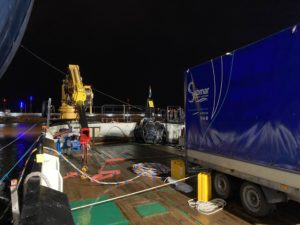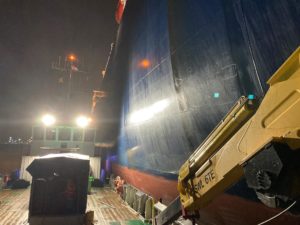Just before the weekend a huge ice-class gastanker full of LNG-gas arrived in the port of Zeebrugge and was very carefully brought to its berth in the outer port.
As soon as the tugboots had left the port and the gas transfer was stable, we were given permission to approach the LNG-tanker alongside and to moor our workboat. After a strict safety procedure that took several hours we could get to work.
Our task was to clean and polish the propeller to the specified surface fineness. That was quite a tough job for the divers. Cleaning a five-blade propeller with a diameter of 8,6 metres to perfection and polishing it to a very fine grade means hard work for the divers and constant focus.
It is of the utmost importance that the divers always deliver the same quality during polishing. This means that each blade must be polished as finely as the others to avoid imbalance and vibrations. The control is done visually by comparing with the internationally recognised standard through control photo samples. With a visibility of barely five centimetres, this is not an easy task.
Six hours after the first diver entered the water, the work was completed.
We now know that this ship will consume 3 to 5% less fuel. But more importantly, it will also emit 3 to 5% less CO2 and that makes us even happier. For a tanker of this size, this means that we will be taking more than 3,000 cars off the road, and that for months!
Another satisfied customer!




